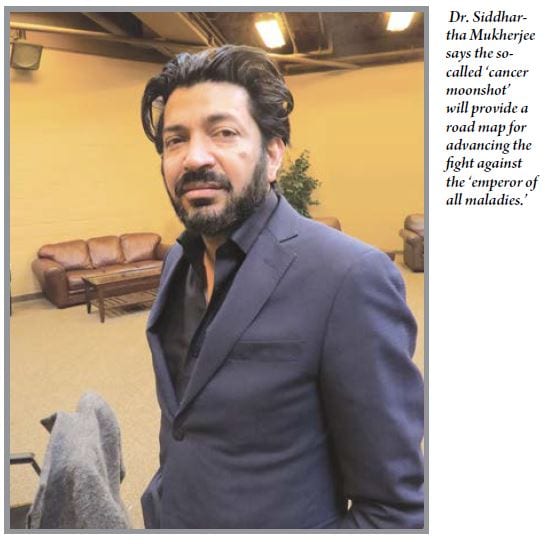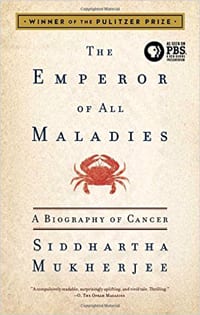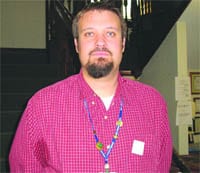A Road Map for Defeating Cancer – Emperor of All Maladies Author Says the Pieces Are in Place
As he delivered his talk, “The Changing Landscape of Cancer,” to a large audience at CityStage earlier this month, Dr. Siddhartha Mukherjee had a PowerPoint presentation running on a large screen behind him.
In a way, it represented a seriously condensed but still highly informative version of his book, The Emperor of All Maladies: A Biography of Cancer, for which he won the 2011 Pulitzer Prize for general nonfiction, and it led with what amounted to a trailer for the Ken Burns-produced PBS film documentary based on the book.
One of the slides, kept on the screen for several minutes, depicted one of the now-famous full-page ads that ran in newspapers across the country in December 1969 with the screaming headline: “Mr. Nixon: You Can Cure Cancer.”
While one might debate whether those spots legally constituted false advertising, Mukherjee implied, they certainly amounted to wishful thinking — very wishful thinking.

Indeed, neither the nation’s president nor anyone else could cure cancer 47 years ago, he explained, because the scientific community simply didn’t know enough about the disease to remotely approach that ambitious goal.
Mukherjee said those ads, inspired by and paid for by Mary Lasker, the noted health activist, philanthropist, and champion of medical research, were a prime catalyst for what he called “the war on cancer 1.0” — a war declared far too early to result in even partial victory, but one that set the stage for later triumphs.
“We had no understanding of the physiology of a cancer cell, let alone what caused it to turn cancerous, and yet a war on cancer was launched without that understanding,” he told his audience, there, as he was, to celebrate the expansion of the Sr. Mary Caritas Cancer Center. “People have often said that this is like saying, ‘we’re going to the moon’ without having seen a jet engine; that’s what the situation was like.”
Nearly a half-century and seven U.S. presidents later (many of whom have declared what amounted to their own versions of a war on cancer), the situation is much different, said Mukherjee, because the world knows exponentially more about the physiology of a cancer cell and why a cell becomes cancerous.
And this new landscape certainly provides more optimism for the latest declared war on this disease — the so-called ‘cancer moonshot’ (a term that only reinforces Mukherjee’s analogy) — that was announced in January.
“We understand cancer at a cellular and molecular level that we didn’t understand before,” Mukherjee told HCN prior to his talk. “We understand what causes cancer, we understand its progression, we understand some, but not all, of its risk factors, and we have not one, not two, but really several dozen important breakthrough therapies for several forms of cancer.
“The question now is how to deliver those therapies carefully, how to deliver them to the right people, how to pay for them, and much more,” he went on. “Meanwhile, there are many cancers that are difficult to cure and difficult to treat, and they will remain frontiers.”
In essence, the cancer moonshot is expected to yield a road map (a term Mukherjee would use early and often) — actually, several of them — for crossing those frontiers and answering all those questions, he went on, adding that this initiative will bring new layers of progress to what he called a “transformative impact” on understanding and treating the many cancers seen over the past half-century.
For this issue and its focus on the business of aging, HCN took the opportunity to talk with one of the world’s leading cancer physicians about the stunning progress achieved to date and how the next chapter in cancer’s biography will unfold.
A Hard Cell
Reducing a few thousand years of conflict between humans and cancer down to a 55-minute presentation wasn’t easy, but Mukherjee, an assistant professor of Medicine at Columbia University and staff physician at Columbia University Medical Center in New York City, managed by focusing on basic science, the milestones in the history of cancer treatment, and the people who made them possible.
Thus, his powerpoint featured slides on everything from surgeon William Halsted’s 19th-century “radical mastectomy” to Mary Lasker’s newspaper ads, and on everyone from Rudolph Virchow, often called the father of modern pathology and noted for his early work on leukemia, to Sidney Farber, considered the father of modern chemotherapy, to Barbara Bradfield, a pioneer (she was patient zero) in the development of Herceptin, a treatment for breast cancer.
His lecture on the history of the disease and mankind’s attempts to cure it focused on several stages he detailed in his 594-page book. They include, more recently, ‘cancer as a disease of cells’ — the period roughly from 1860 to 1960; ‘cancer as a disease of genes’ (1970-1990); ‘cancer as a disease of genomes’ (1990-2010); and the current stage, ‘cancer as a pathway disease.’
He brought his audience from the first identification of cancer some 4,600 years ago by the Egyptian physician Imhotep to current events, including groundbreaking initiatives to rapidly determine the sequencing of genes in tumor cells, leading to new treatment platforms.
Describing what’s been accomplished to date, he used words such as “remarkable” and “unprecedented,” words he says are fitting given the resilience, complexity, and sheer uniqueness of the disease and each case of it.
“Every single cancer, at the genetic level and the genomic level, is its own cancer, and every single patient is its own patient,” he explained. “We knew this 100 years ago, but we really learned this 100 years later.
“There is no disease — and I will argue that there are few problems in human history — where the level of diversity of the problem, the level of complexity of the problem, is equal to the number of people who have the problem,” he went on, urging his audience to consider the magnitude of what he just said. “Cancer is that problem … and that makes it different than any other disease, and that’s what makes it the emperor of all maladies.”
But while his book, and his lecture, amounted to history lessons, Mukherjee said his current focus is obviously on what comes next, and this brings him back to the cancer moonshot.
“This is an incredibly important effort,” he told HCN before his talk. “It clarifies what the goals are, and that is to have a transformative effect on cancer care over the next 100 years.”
When asked what the initiative, officially named Cancer Moonshot 2020, might accomplish by that date, he said simply, “a line in the sand,” before elaborating and returning to that analogy of drawing a road map.
“What will happen over the next four years is that we will clarify that road map, which will hopefully stay with us for the next 80 to 100 years to remind us what the big goals are and whether we met the goals or didn’t meet the goals,” he explained. “We may at times go off the road because we don’t understand something, but as long as we have a sense of what that landscape is like, we can stay on track.”
Again, there will likely be several road maps drawn, he went on, adding that there are, indeed, several fronts in any war on cancer.
One is obviously treatment, he said, noting that considerable progress has been made with some cancers, including blood cancers — leukemia and lymphomas — as well as lung cancer, breast cancer, colon cancer, and prostate cancer.
Another front is prevention, which of course plays a huge role in the larger effort to stem the tide of the disease and greatly reduce the numbers of individuals who will die from it. And within the discussion concerning prevention lies the overarching question concerning whether cancer — or specific cancers — can indeed be prevented.
Some carcinogens, such as smoking, have been identified, said Mukherjee, adding that great uncertainty remains about how many more are still to be recognized. And this is a huge issue moving forward.
“That’s an open question on the table and a very important question: are there still out there major preventable chemical carcinogens — have we missed some?” he asked rhetorically.
“And if we haven’t missed some, what do we do about the fact that the rest of it is spontaneous errors, accidents when cells divide?” he went on. “That has many, many, many consequences, and there have been four or five highly controversial papers back to back in major scientific journals, one claiming the former, the second claiming the latter, one saying it has to do with cells making errors when they divide, the other making the claim that the environmental impact has been underappreciated, and there may be some hidden, unknown carcinogenic input.
“We need to sort that answer out,” he continued, “because it’s a fork in the road, whether we move in one direction or the other.”
There will be several similar forks to confront in the years to come, he said, adding that, beyond treatment and prevention, there are other large issues to be addressed, such as handling the cost of this battle, deciding how resources are to be committed, and drafting a plan for making this a truly international moonshot, not a solely American initiative.
Prescription for Progress
Almost immediately after Cancer Moonshot 2020 was announced, skeptics said it is as unlikely to achieve its stated goals as the initiative launched by President Nixon nearly five decades ago.
Mukherjee is far more optimistic. He notes that the pace of progress has greatly accelerated in recent years as more becomes known about the disease, and that enough will soon be known to not only draw a map, but enable society to reach its destination, one where cancer is far less the killer that it is now.
And he should know. After all, he wrote the book on the subject — a biography for which there are many chapters still to write.




Comments are closed.